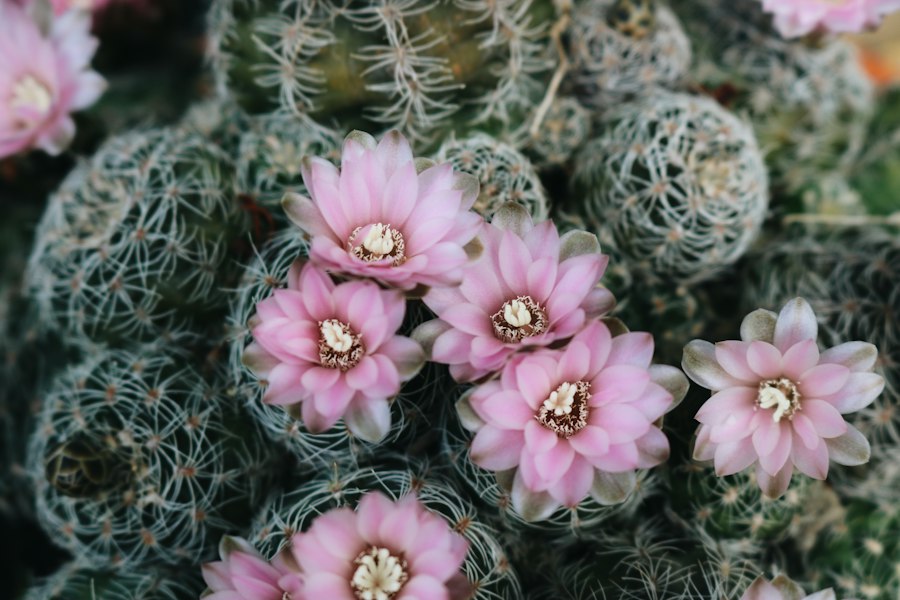From Seed to Succulent: A Guide to Growing Cacti from Scratch

Cacti are a popular choice for plant enthusiasts due to their unique and striking appearance. These desert plants have gained popularity in recent years, with many people incorporating them into their homes and gardens. However, caring for cacti requires a good understanding of their growth habits and specific needs. In this article, we will explore the various aspects of cacti care, including soil and pot selection, watering techniques, light and temperature requirements, propagation methods, pest and disease management, fertilization techniques, pruning and shaping tips, repotting guidelines, and creative display ideas.
Key Takeaways
- Understanding the basics of cacti growth is essential for successful cultivation.
- Choosing the right soil and pot is crucial for cacti health and growth.
- Watering cacti requires a delicate balance and adherence to specific dos and don’ts.
- Light and temperature requirements vary by cactus species and must be carefully monitored.
- Propagating cacti can be a fun and rewarding way to multiply your plants.
Choosing the Right Soil and Pot for Your Cactus
One of the most important factors in successful cactus care is choosing the right soil. Cacti require well-draining soil to prevent root rot and other moisture-related issues. A good cactus soil mix should consist of a combination of organic matter, such as peat moss or coconut coir, and inorganic materials like perlite or pumice. This mixture allows excess water to drain away quickly while retaining enough moisture for the plant’s needs.
When it comes to pots, there are several options to choose from. Clay pots are a popular choice as they allow for better airflow and water evaporation. However, they can also dry out quickly, so it’s important to monitor the moisture levels closely. Plastic pots are another option that retains moisture better but may not provide adequate airflow. Ultimately, the choice of pot depends on personal preference and the specific needs of your cactus.
Repotting cacti is necessary when they outgrow their current containers or when the soil becomes compacted. It’s best to repot during the spring or early summer when the plant is actively growing. When repotting, gently remove the cactus from its current pot and shake off any excess soil. Place it in a slightly larger pot with fresh cactus soil, making sure to position it at the same depth as before. Allow the plant to settle for a few days before watering.
Watering Your Cacti: Dos and Don’ts
Watering is a crucial aspect of cactus care, and understanding the proper techniques is essential for their health. Cacti are adapted to survive in arid environments and have unique water storage capabilities. As a general rule, it’s better to underwater than overwater cacti. Overwatering can lead to root rot and other fungal diseases, while underwatering can cause dehydration and stunted growth.
The frequency and amount of watering depend on various factors such as the size of the pot, the type of soil, and the environmental conditions. As a general guideline, water your cactus thoroughly when the top inch of soil feels dry. Use a watering can with a narrow spout to direct the water directly to the base of the plant, avoiding the spines. Allow any excess water to drain away completely.
Signs of overwatering include yellowing or mushy stems, black spots on the base of the plant, and a foul smell. On the other hand, signs of underwatering include shriveled or wrinkled stems and a lack of new growth. It’s important to observe your cactus closely and adjust your watering routine accordingly.
Light and Temperature Requirements for Healthy Cacti Growth
| Light Requirements | Temperature Requirements |
|---|---|
| Full sun to partial shade | Daytime: 70-85°F (21-29°C) Nighttime: 60-70°F (15-21°C) |
| At least 6 hours of direct sunlight per day | Avoid temperatures below 50°F (10°C) and above 95°F (35°C) |
| South-facing windows are ideal | Provide good air circulation to prevent overheating |
| Artificial light can be used to supplement natural light | Avoid sudden temperature changes and drafts |
Cacti thrive in bright light conditions, preferably with direct sunlight for several hours each day. Placing them near a south-facing window or outdoors in a sunny spot is ideal. However, it’s important to acclimate your cactus gradually to direct sunlight if it has been kept in low light conditions.
When it comes to temperature requirements, most cacti prefer warm temperatures between 70-90°F (21-32°C) during the growing season. They can tolerate higher temperatures but may require some shade during the hottest part of the day. During the winter months, cacti appreciate cooler temperatures between 50-60°F (10-15°C) to promote dormancy.
Extreme temperatures can be detrimental to cacti. Frost can cause damage or even kill the plant, so it’s important to protect them during cold weather. If you live in an area with freezing temperatures, it’s best to bring your cacti indoors or provide them with adequate protection, such as covering them with frost blankets or moving them to a sheltered location.
Propagating Cacti: How to Multiply Your Plants
Propagating cacti is a rewarding way to expand your collection or share plants with friends and family. There are several methods of propagation, including seeds, cuttings, and offsets.
Seeds are the most common method of propagating cacti. To start from seeds, sow them in a well-draining cactus soil mix and keep them warm and moist until germination occurs. This process can take several weeks or even months, depending on the species. Once the seedlings have grown large enough, they can be transplanted into individual pots.
Cuttings involve taking a piece of a mature cactus and allowing it to develop roots. To propagate through cuttings, use a sharp, sterile knife or scissors to cut a healthy stem segment from the parent plant. Allow the cutting to dry for a few days until a callus forms over the cut end. Then, place the cutting in a well-draining soil mix and water sparingly until roots develop.
Offsets, also known as pups or babies, are small offshoots that grow from the base of mature cacti. These can be gently separated from the parent plant and potted up individually. It’s important to wait until the offsets are large enough to ensure successful transplantation.
Dealing with Common Cacti Pests and Diseases

Like any other plants, cacti are susceptible to pests and diseases. Some common pests that can affect cacti include mealybugs, scale insects, spider mites, and aphids. These pests can cause damage to the plant by sucking sap or leaving behind a sticky residue. To manage pest infestations, it’s important to regularly inspect your cacti and take prompt action if any signs of pests are detected.
Diseases that can affect cacti include fungal infections such as root rot and stem rot. These diseases are often caused by overwatering or poor drainage. To prevent fungal infections, it’s important to ensure that the soil is well-draining and that the plant is not sitting in excess water. If you notice any signs of disease, such as soft or discolored stems, it’s best to remove the affected parts and treat the plant with a fungicide.
Preventing pests and diseases is key to maintaining healthy cacti. Avoid overwatering, provide adequate airflow around the plants, and regularly inspect them for any signs of trouble. Quarantine new plants before introducing them to your collection to prevent the spread of pests or diseases.
Cacti Fertilization: What You Need to Know
Cacti have specific nutritional needs, and fertilization can help promote healthy growth and flowering. There are various types of fertilizers available for cacti, including liquid fertilizers, slow-release granules, and organic options.
When it comes to fertilizing cacti, it’s important to follow the instructions on the fertilizer package. As a general guideline, fertilize your cacti during the growing season (spring and summer) and reduce or stop fertilization during the dormant period (fall and winter). Overfertilizing can lead to nutrient burn or excessive growth, so it’s important to use fertilizers sparingly.
Pruning and Shaping Your Cacti: Tips and Techniques
Pruning cacti is not always necessary but can be done for various reasons. Pruning can help remove dead or damaged parts, promote a more compact growth habit, or shape the plant for aesthetic purposes. It’s important to use clean, sharp pruning tools to prevent the spread of diseases.
Before pruning, assess the plant and determine which parts need to be removed. Use pruning shears or a sharp knife to make clean cuts just above a node or joint. If you’re shaping the cactus, make strategic cuts to encourage branching or create a desired form. After pruning, allow the plant to dry for a few days before watering.
Cacti Repotting: When and How to Do It
Repotting cacti is necessary when they outgrow their current containers or when the soil becomes compacted. Signs that your cactus needs repotting include roots growing out of the drainage holes, the plant becoming top-heavy, or the soil taking longer to dry out between waterings.
To repot your cactus, gently remove it from its current pot by loosening the soil around the edges. Shake off any excess soil and inspect the roots for any signs of damage or rot. If necessary, trim any damaged roots with clean, sharp scissors. Place the cactus in a slightly larger pot with fresh cactus soil, making sure to position it at the same depth as before. Allow the plant to settle for a few days before watering.
Showcasing Your Cacti: Creative Display Ideas for Your Home or Garden
Cacti can be displayed in various creative ways to enhance their beauty and create a visually appealing arrangement. Indoor display ideas include grouping different types of cacti together on a windowsill or creating a mini desert garden in a terrarium or glass container. Outdoor display ideas include planting cacti in rock gardens, raised beds, or decorative pots.
For a DIY display option, consider repurposing old containers or creating your own planters using materials like concrete, wood, or ceramic. You can also incorporate other elements such as rocks, pebbles, or driftwood to create a natural-looking display. It’s important to consider the specific needs of your cacti when choosing a display option, such as ensuring adequate drainage and protection from extreme weather conditions.
To create a cohesive cactus collection, consider grouping plants with similar growth habits or colors together. You can also experiment with different heights and textures to create visual interest. Regularly rotate your cacti to ensure even growth and prevent them from leaning towards the light source.
Caring for cacti can be a rewarding and enjoyable experience. By understanding their specific needs and following proper care techniques, you can ensure the health and longevity of your plants. Remember to choose the right soil and pot, water your cacti correctly, provide adequate light and temperature conditions, propagate them to expand your collection, manage pests and diseases effectively, fertilize them appropriately, prune and shape them as needed, repot when necessary, and showcase them creatively in your home or garden. With these tips and techniques in mind, you’ll be well-equipped to care for your cacti and enjoy their beauty for years to come.



